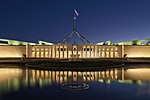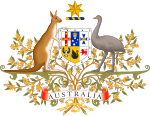Australian Capital Territory

The Australian Capital Territory (ACT), known as the Federal Capital Territory (FCT) until 1938, is a federal territory of Australia. Canberra, the capital city of Australia, is located in this territory. It is located in southeastern Australian mainland as an enclave completely within the state of New South Wales. Founded after Federation as the seat of government for the new nation, the territory hosts the headquarters of all important institutions of the Australian Government. On 1 January 1901, federation of the colonies of Australia was achieved. Section 125 of the new Australian Constitution provided that land, situated in New South Wales and at least 100 mi (160 km) from Sydney, would be ceded to the new federal government. Following discussion and exploration of various areas within New South Wales, the Seat of Government Act 1908 was passed in 1908 which specified a capital in the Yass-Canberra region. The territory was transferred to the federal government by New South Wales in 1911, two years prior to the capital city being founded and formally named as Canberra in 1913. While the overwhelming majority of the population reside in the city of Canberra in the ACT's north-east, the territory also includes some towns such as Williamsdale, Oaks Estate, Uriarra, Tharwa and Hall. The ACT also includes the Namadgi National Park which comprises the majority of land area of the territory. Despite a common misconception, the Jervis Bay Territory is not part of the ACT although the laws of the Australian Capital Territory apply as if Jervis Bay did form part of the ACT. The territory has a relatively dry, continental climate experiencing warm to hot summers and cool to cold winters. The Australian Capital Territory is home to many important institutions of the federal government, national monuments and museums. This includes the Parliament of Australia, the High Court of Australia, the Australian Defence Force Academy and the Australian War Memorial. It also hosts the majority of foreign embassies in Australia as well as regional headquarters of many international organisations, not-for-profit groups, lobbying groups and professional associations. Several major universities also have campuses in the ACT including the Australian National University, the University of Canberra, the University of New South Wales, Charles Sturt University and the Australian Catholic University. A locally elected legislative assembly has governed the territory since 1988. However, the Commonwealth maintains authority over the territory and may overturn local laws. It still maintains control over the area known as the Parliamentary Triangle through the National Capital Authority. Residents of the territory elect three members of the House of Representatives and two senators. With 453,324 residents, the Australian Capital Territory is the second smallest mainland state or territory by population. At the 2016 census, the median weekly income for people in the territory aged over 15 was $998, significantly higher than the national average of $662. The average level of degree qualification in the ACT is also higher than the national average. Within the ACT, 37.1% of the population hold a bachelor's degree level or above education compared to the national figure of 20%.In September 2022, it was announced the border between NSW and the ACT would change for the first time since it was created in 1911. ACT chief minister Andrew Barr said NSW premier Dominic Perrottet had agreed to a proposed border change of 330 ha (1.3 sq mi) in the Ginninderra watershed.
Excerpt from the Wikipedia article Australian Capital Territory (License: CC BY-SA 3.0, Authors, Images).Australian Capital Territory
Parliament Drive,
Geographical coordinates (GPS) Address Nearby Places Show on map
Geographical coordinates (GPS)
| Latitude | Longitude |
|---|---|
| N -35.308055555556 ° | E 149.12444444444 ° |
Address
Parliament Drive
2600 , Capital Hill
Australia
Open on Google Maps






